On This Page: [hide]
With its user-friendly design tools and reliability, this platform stands out as a formidable ally for entrepreneurs and small businesses eager to thrive online.
In this deep dive, we’ll explore Web.com’s robust offerings, performance, and pricing, ensuring you’re well-informed to make the best decision for your digital journey. Whether you’re building a basic website or a complex e-commerce platform, understanding what Web.com truly brings to the table is your first step towards a successful online endeavor.
 Visit Site
Visit Site 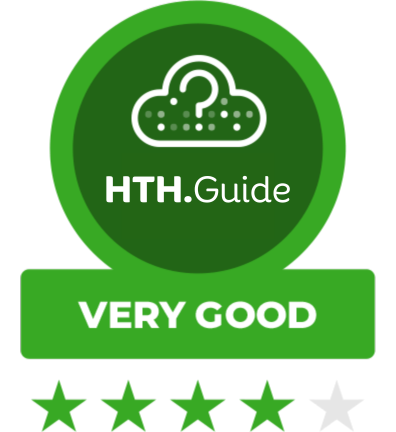
| Name | Web.com |
| Total Reviews | 2778 |
| Average Score | 4.0 |
| Website | http://www.web.com |
| Address | 5335 Gate Pkwy Jacksonville , FL 32256 US |
Number of Reviews
Avg. Review Score
Customer Support
Decoding Web.com: What It Really Offers
Understanding the full suite of offerings by Web.com is essential for anyone considering taking their business online or enhancing their digital presence. Web.com has established itself as a versatile platform that catifs to a wide range of digital needs.
From domain registration to website creation and advanced e-commerce solutions, it presents a consolidated toolkit for entrepreneurs, small businesses, and growing enterprises alike. This overview dives into the core features and auxiliary services that make Web.com a go-to digital partner for many.
Exploring Web.com’s Core Features and Services
At the heart of Web.com’s offerings is its user-friendly website builder that enables anyone to craft a professional-looking website with no technical background. This ease of use extends to their e-commerce solutions, designed to simplify online selling.
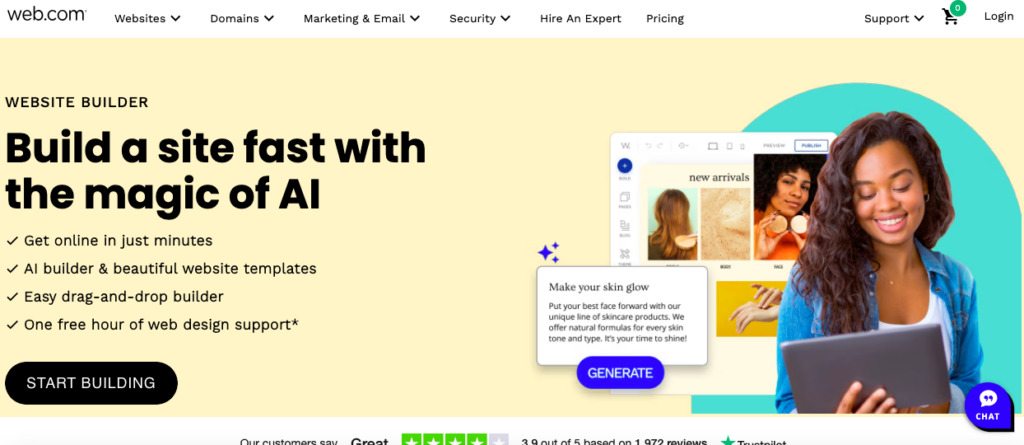
Users have access to a variety of stylish templates tailored for different business sectors, alongside essential site tools like SEO and analytics integration. Moreover, Web.com’s commitment to reliability is evident with its promise of 99.99% uptime, ensuring that websites remain accessible to their audience around the clock.
- Template Variety: With themes ranging from auto dealerships to coffee shops, users can quickly find a design that speaks to their brand identity.
- SEO and Analytics: Integrated tools that assist in monitoring and enhancing site visibility, along with insights into visitor behavior.
- Reliability: A robust infrastructure that supports a 99.99% uptime rate, coupled with free domain name registration for a smooth start.
Adding to its core website services, Web.com offers a range of marketing and design services, including AI-powered tools for designing logos and writing copy, making it easier for businesses to establish and grow their online presence.
Does Web.com Support E-commerce Websites?
Yes, Web.com stands out with its comprehensive support for e-commerce websites. Recognizing the varied needs of online retailers, it provides an array of features to manage and scale your e-commerce operations efficiently.
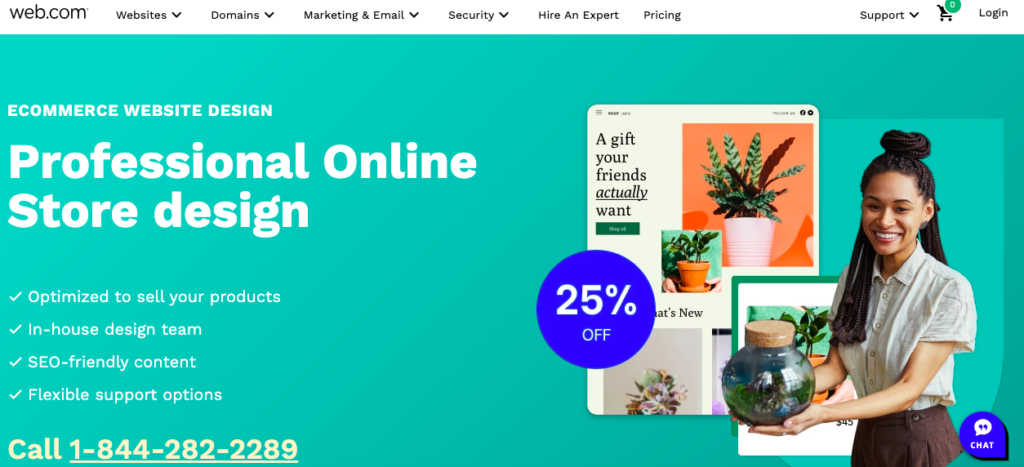
From inventory management to multi-marketplace listings on platforms like Etsy, Amazon, and eBay, Web.com centralizes your online retail activities. Its automated inventory sync and supplier connection capabilities ensure that product data and orders are always up-to-date, preventing overselling and streamlining the fulfillment process.
- E-commerce Plans: Catering to different business sizes with its eCommerce Essentials and Premium plans, enabling the sale of unlimited products and seamless integration with major shipping carriers for real-time rates.
- Marketplace Integration: Easily list products on multiple online marketplaces, managing all customer orders from a single dashboard, enhancing operational efficiency.
- Inventory and Supplier Management: Automated synchronization keeps product quantities accurate across all sales channels and suppliers’ systems, ensuring a smooth order fulfillment process.
Furthermore, the platform’s e-commerce features extend to creating a mobile-responsive store, setting up various payment gateways like PayPal and Stripe, and optimizing the online shopping experience with customizable product and category pages.
Despite some limitations in digital product offerings and localized options such as in-store pickup, Web.com provides a solid foundation for businesses looking to expand their online sales.
The Pros and Cons of Choosing Web.com
When embarking on your online journey, picking the right website builder is crucial for shaping the initial path of your digital presence.
Web.com offers tools and features that cater to businesses eager to establish or expand their online footprint, yet, like all website builders, it comes with both strengths and weaknesses. Here, we’ll explore the advantages that might make Web.com the go-to choice for some users, as well as the limitations that could be deal-breakers for others.
Why Web.com Might Be Your Go-To Website Builder
Web.com positions itself as a straightforward platform for users looking to create a web presence with minimal fuss. Its drag-and-drop editor simplifies the design process, making it accessible to users regardless of their technical skill level.

The platform also stands out for its focus on eCommerce, offering an array of tools designed to help small businesses not only get online but thrive in a competitive digital marketplace.
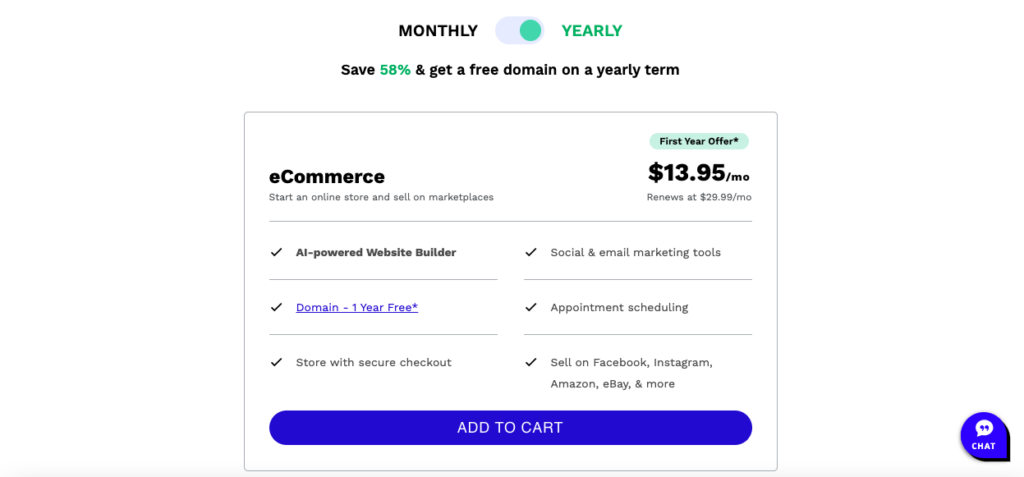
From easily integrated apps that extend the functionality of your website to a range of templates organized by industry, Web.com provides a decent starting point for businesses embarking on their online journey.
- Structured Design Approach: For those who appreciate guidance in their design process, Web.com’s template-based system offers a skeleton framework that helps maintain a cohesive look while making the website building process simpler.
- eCommerce Functionality: If you’re looking to open an online store, Web.com’s focus on eCommerce tools can be a significant advantage. The platform offers features aimed at enhancing online selling and digital transactions.
- Professional Templates: With over 100 templates split across various industries, Web.com provides a base for professional-looking websites. While customization options might be limited, the available designs aim to meet basic business needs.
However, it’s essential for potential users to weigh these benefits against the platform’s limitations to determine if Web.com aligns with their specific needs and expectations for a website builder.
Limitations of Web.com You Can’t Ignore
Despite the advantages, certain aspects of Web.com might deter users, especially those with specific requirements or desires for their website’s functionality and design.
- Limited Creative Control: Users seeking a freeform design experience may find the row-based template structure restrictive, confining the customization to a grid without allowing elements to be placed freely.
- High Renewal Rates: Attractive introductory offers may lead to surprise when the time comes for renewal, with prices jumping significantly, which could impact budget-conscious businesses.
- Basic Feature Set: While adequate for straightforward websites, Web.com’s features might not suffice for those looking to build a more complex or feature-rich online presence. Specifically, the absence of advanced features like promotional pop-ups, booking systems, or a fully fleshed-out blogging platform can be limiting.
- Customer Support Challenges: While offering phone support, reports of focused upselling rather than problem-solving can detract from the user experience, complicating straightforward tasks like troubleshooting or obtaining assistance.
While Web.com might offer a suitable platform for users looking for simplicity and ease of use, those aiming for more elaborate websites or specific functionalities might find the limitations a hindrance. It’s crucial to consider these aspects when choosing Web.com as your website building partner.
- Web.com reviews from United States
| Average score | 4.25 |
| Number of reviews | 2127 reviews |
- Web.com reviews from Canada
| Average score | 4.00 |
| Number of reviews | 148 reviews |
- Web.com reviews from United Kingdom
| Average score | 2.22 |
| Number of reviews | 146 reviews |
- Web.com reviews from Australia
| Average score | 3.00 |
| Number of reviews | 30 reviews |
- Web.com reviews from Spain
| Average score | 2.37 |
| Number of reviews | 13 reviews |
- Web.com reviews from Mexico
| Average score | 3.91 |
| Number of reviews | 11 reviews |
- Web.com reviews from Switzerland
| Average score | 3.40 |
| Number of reviews | 10 reviews |
- Web.com reviews from Netherlands
| Average score | 3.00 |
| Number of reviews | 8 reviews |
- Web.com reviews from Philippines
| Average score | 3.86 |
| Number of reviews | 7 reviews |
- Web.com reviews from Ireland
| Average score | 3.40 |
| Number of reviews | 7 reviews |
- Web.com reviews from United Arab Emirates
| Average score | 3.00 |
| Number of reviews | 7 reviews |
- Web.com reviews from Italy
| Average score | 3.14 |
| Number of reviews | 7 reviews |
- Web.com reviews from Sweden
| Average score | 3.71 |
| Number of reviews | 7 reviews |
- Web.com reviews from India
| Average score | 3.57 |
| Number of reviews | 6 reviews |
- Web.com reviews from Nigeria
| Average score | 2.17 |
| Number of reviews | 6 reviews |
- Web.com reviews from Pakistan
| Average score | 4.33 |
| Number of reviews | 6 reviews |
- Web.com reviews from Belgium
| Average score | 2.83 |
| Number of reviews | 6 reviews |
- Web.com reviews from Singapore
| Average score | 4.33 |
| Number of reviews | 6 reviews |
- Web.com reviews from New Zealand
| Average score | 2.00 |
| Number of reviews | 6 reviews |
- Web.com reviews from Israel
| Average score | 1.00 |
| Number of reviews | 5 reviews |
- Web.com reviews from France
| Average score | 2.60 |
| Number of reviews | 5 reviews |
- Web.com reviews from Denmark
| Average score | 1.00 |
| Number of reviews | 5 reviews |
- Web.com reviews from Indonesia
| Average score | 3.00 |
| Number of reviews | 4 reviews |
- Web.com reviews from Japan
| Average score | 4.00 |
| Number of reviews | 4 reviews |
- Web.com reviews from Chile
| Average score | 2.50 |
| Number of reviews | 4 reviews |
- Web.com reviews from South Africa
| Average score | 3.00 |
| Number of reviews | 4 reviews |
- Web.com reviews from Taiwan
| Average score | 3.75 |
| Number of reviews | 4 reviews |
- Web.com reviews from Turkey
| Average score | 5.00 |
| Number of reviews | 4 reviews |
- Web.com reviews from Puerto Rico
| Average score | 5.00 |
| Number of reviews | 3 reviews |
- Web.com reviews from Cyprus
| Average score | 4.33 |
| Number of reviews | 3 reviews |
User Experience: Navigating Web.com’s Platform
Creating a website with Web.com is presented as a straightforward process, especially for those taking their first steps into building an online presence. This approach is vividly seen in the ease of signing up and diving into the array of features designed to get a site off the ground.
As users step into Web.com’s ecosystem, they’re guided through an initial phase with tutorial videos. While these tutorials aim to flatten the learning curve, a layer of pre-existing computer knowledge will indeed make the experience smoother.
The clean and intuitive interface of Web.com suits beginners and those with some technical skills alike. This dual appeal is significant, considering the vast demographic Web.com targets. From the selection of mobile-optimized templates to the hands-on support, Web.com structures its user experience on a foundation of simplicity.
However, the platform also brings an unspoken expectation: to leverage its full potential, diving a bit deeper beyond the surface will enrich the user journey. This means that while initial steps are simplified, crafting a website that’s both functional and aesthetically pleasing might require a bit more exploration and patience.
Is Web.com Ideal for Beginners?
The question of whether Web.com suits beginners is layered. On one side, its drag-and-drop interface, coupled with a selection of pre-designed templates, positions Web.com as an inviting starting point for novices.
Users can quickly feel a sense of accomplishment as they pick a theme, tweak the layout, and publish their first page without touching a line of code. This simplicity is further bolstered by the inclusion of a free domain name and a custom email address, laying down the fundamentals of establishing an online identity with ease.
Conversely, its simplicity can be a double-edged sword. The platform’s limitations in customization and the inability to tweak HTML and CSS might deter those who wish to add a personal touch beyond the basics.
Moreover, the lack of a free trial or money-back guarantee places a bit more weight on the decision to commit, as beginners won’t have the opportunity to explore without upfront payment.
In essence, Web.com provides a balanced compromise. It’s an environment where beginners can confidently take their first steps, backed by useful AI tools and support.
However, it also sets the stage for growth, encouraging users to expand their skills and explore further possibilities within Web.com’s framework. For newcomers in the digital space seeking a blend of simplicity, support, and scalability, Web.com emerges as a platform worth considering.
Yet, it’s important for users to acknowledge that growing their online presence might eventually require stepping beyond basic offerings.
As such, while Web.com lays down the foundational stones, the journey towards a more complex and unique digital footprint might require exploration outside its confines.
For those initial steps, however, Web.com simplifies the path to online visibility. Its array of templates, intuitive design tools, and supportive resources blend to offer a user-friendly experience.
While limitations exist, they do not overshadow the platform’s capability to serve as a solid starting point for many.
- Bandwidth Unlimited
- Panel cPanel
- Number of Sites 1
- Bandwidth Unlimited
- Panel cPanel
- Number of Sites 5
- Bandwidth Unlimited
- Panel cPanel
- Number of Sites 10
- Bandwidth Unlimited
- Bandwidth Unlimited
- Bandwidth Unlimited
Understanding Web.com Pricing: Hidden Costs?
Exploring Web.com’s pricing reveals a structure that might initially seem straightforward but contains nuances every potential user should be aware of.
While the service boasts attractive introductory prices for the first month across its various plans, a deeper dive into the specifics shows the emergence of potential additional expenses not immediately apparent.
These hidden costs can primarily arise from two sources: the significant increase in pricing post the introductory period and the need for essential add-ons not included in the base plan prices.
After the first month’s heavily discounted rate, the monthly fees see a steep increase. This jump is standard in the tech industry but might catch some users off guard if they aren’t fully informed beforehand.
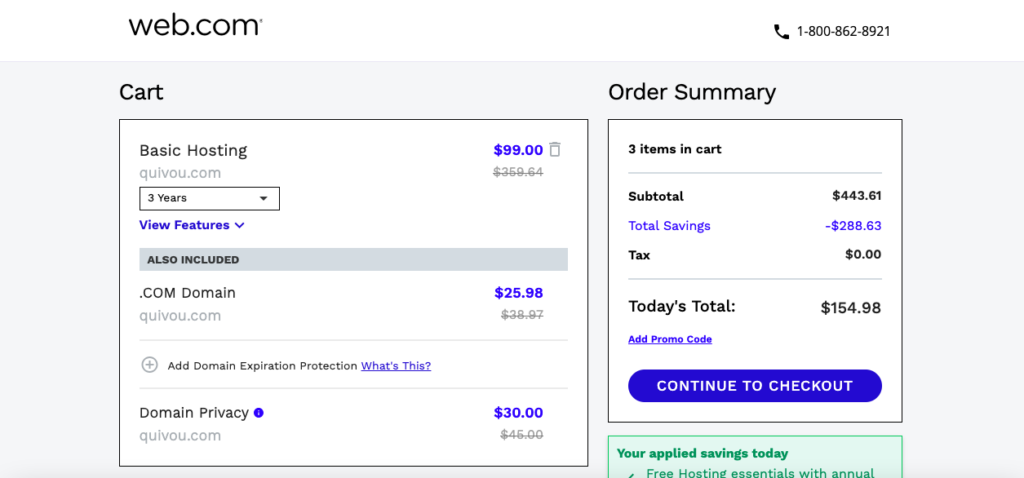
Also, certain essential features like SSL certification and ecommerce capabilities which are critical for many websites today are not included in the base package.
Instead, they require separate payments, which can substantially increase the overall cost. Moreover, the domain name renewal fee post the first year and the costs associated with expanding your site’s capabilities can further escalate your expenses.
Comparing Web.com’s Price Plans for Different Needs
Web.com offers a range of pricing plans designed to meet different needs, from basic website creation to comprehensive online store features.
However, understanding which plan best aligns with your needs requires careful consideration of each plan’s offerings versus its costs.
- The Website Builder plan is suitable for users aiming to establish a basic online presence without the complexities of ecommerce or advanced SEO tools.
- The Website and Online Marketing plan adds marketing services, including SEO consultation and business directory submissions, tailored for those looking to expand their reach online.
- For small business owners intending to sell products online, the Website, Marketing and Store plan offers ecommerce functionalities alongside the benefits of the previous plans.
While all plans come with an introductory discount for the first month, evaluating the full cost that kicks in from the second month is crucial.
Additionally, considering the extra expenses for essential add-ons and the billing cycle every 4 weeks (not monthly), helps in making a more informed decision.
Free Trial and Refund Policy: What You Need to Know
One notable aspect of Web.com’s approach is the absence of a traditional free trial, which might deter some potential users from trying their service before committing financially.
Instead of offering a no-cost trial period, Web.com opts for a low introductory price for the first month across all plans. This strategy, while providing an entry point at a reduced cost, still requires upfront payment, which might not appeal to all users.
Also, while Web.com promotes a 30-day money-back guarantee, user experiences suggest that obtaining a refund can be challenging. Issues such as difficulties in reaching customer support and navigating the refund process have been reported.
Prospective users should weigh this aspect carefully, considering potential challenges in recovering their initial investment if the service doesn’t meet their expectations.
In summary, while Web.com’s pricing and plans offer a variety of options tailored to different web development needs, users should be mindful of the hidden costs, the steep price increase after the introductory offer, and the implications of the refund policy.
Performance and Reliability: Analyzing Web.com
When choosing a web hosting provider, two crucial factors often come to the forefront: performance and reliability. Web.com has garnered attention for its efforts in these areas, boasting features that aim to cater to the needs of various users.
Let’s dive deeper into how Web.com fares in these critical aspects.
Web.com Uptime Records: What the Data Shows
Uptime reflects the reliability of a website host – the higher the uptime, the less likely your site will experience downtime. Web.com has impressed with an average uptime of 99.99%, indicating exceptional reliability.
This figure is particularly significant given that uptime directly impacts site accessibility for users and search engine ranking. While Web.com does not offer an uptime guarantee for its website builder specifically, its hosting services come with a 99.9% uptime guarantee, underscoring their commitment to reliability.
A three-week monitoring period revealed only a single minute of downtime, which is an outstanding performance that not many service providers can match.
Site Speed on Web.com: Fast Enough for Modern Needs?
The speed at which your website loads is imperative for keeping the audience engaged and satisfied. Web.com boasts admirable loading times, with tests showing that both empty and fully-built sites on this platform load efficiently.
Specifically, the Largest Contentful Paint (LCP), a crucial metric for measuring perceived load speed, is well below the threshold of 2.5 seconds recommended by Google.

The swift loading times are especially commendable given Web.com’s operation from servers located in the US. However, it’s crucial to note that site speed may vary depending on your proximity to their data centers in Florida and Atlanta. Despite this, Web.com manages to sustain an LCP of just 1.2 seconds for fully built websites, significantly under the ideal limit, and a fully loaded time of 1.8 seconds. This performance is not just a testament to Web.com’s speed but also its capacity to deliver a smooth user experience.
Addressing Web.com’s handling of site traffic, their servers exhibit some limitations when under significant strain. Stress tests reveal that while the platform efficiently manages up to 20,000 monthly visitors, it struggles with higher volumes. This limitation suggests that while Web.com is suitable for small to mid-sized websites, larger sites with high traffic peaks might need to consider scalability options.
Despite these concerns, the overall responsiveness and speed of the service in daily operation remain robust, making Web.com a viable contender for those prioritizing reliability and efficient site performance.
In the evolving landscape of website management, where speed and uptime are invaluable, finding a reliable platform is crucial. Web.com emerges as a strong candidate, with impressive records in both speed and reliability. However, it’s also vital to consider potential traffic growth and choose a service that can scale accordingly.
Security Measures: How Safe is Your Website with Web.com?
When considering building or hosting a website with Web.com, it’s important to understand what security measures are in place to protect your online presence. Web.com offers SSL certificates to encrypt data, ensuring that any information exchanged between your site and its visitors is secured. This is a fundamental step in establishing trust and authenticity online.
Furthermore, Web.com provides around-the-clock security monitoring services. This proactive approach scans for malicious activity and alerts you to any potential threats, enabling prompt action to safeguard your site.
In the online arena, staying one step ahead of cyber threats is crucial for maintaining the integrity and availability of your website.
Web.com also emphasizes the importance of data protection with automatic daily backups. Should anything go amiss, these backups serve as a safety net, ensuring that your website can be restored quickly, minimizing downtime and data loss.
Despite these measures, some critiques point out that Web.com might not offer a comprehensive security strategy compared to other platforms. Essential security features might require additional costs, which is something businesses should consider when planning their website infrastructure.
Template Quality and Variety on Web.com
Choosing the right template for your website is crucial, as it sets the tone and style for your online presence. Web.com offers a broad selection of templates, with more than 150 options available, catering to various industries.
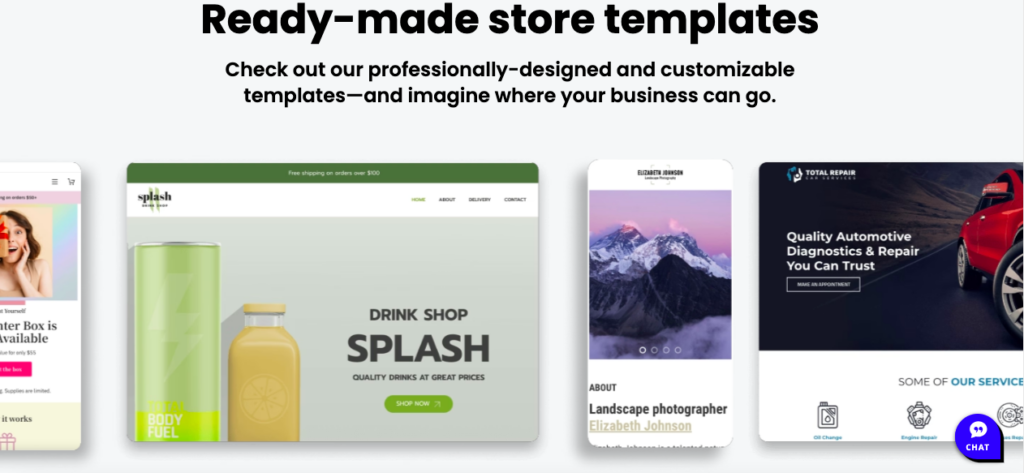
This diversity ensures that whether you’re setting up an online store, a restaurant, or a portfolio, you’ll find something that aligns with your vision. Each template is designed to be mobile-responsive, a key feature in today’s mobile-first internet usage.
While the templates are divided by industry, it’s worth noting that some categories may offer limited choice, with only one or two designs. However, the designs provided are clean and professional, ticking off essential boxes for many users.
Despite this, some may find the designs too similar or lacking in adventurous options. This aspect highlights a balance Web.com attempts to strike between offering variety and maintaining a standard of professionalism in template design.
The real strength of Web.com’s templates lies not just in their initial layout but in the customization options available. This allows users to start with a basic design and tweak it to better fit their unique brand identity.
The choice between single-page and multi-page formats adds another layer of flexibility, catering to different preferences and content volumes.
Customizing Web.com Templates: An In-Depth Look
Web.com empowers its users with straightforward customization tools, crafted to enhance the base layout of templates without the need for extensive web design knowledge.
The customization process is facilitated by a row-based layout system in the site editor, designed for users who value simplicity and ease of use over granular control.
To personalize a template, users can rearrange existing blocks, like galleries and testimonials, or integrate new ones, allowing for a more unique and tailored site design. This flexibility lets users adapt their site to more accurately reflect their brand or business needs. However, Web.com’s customization capabilities do have their limits.
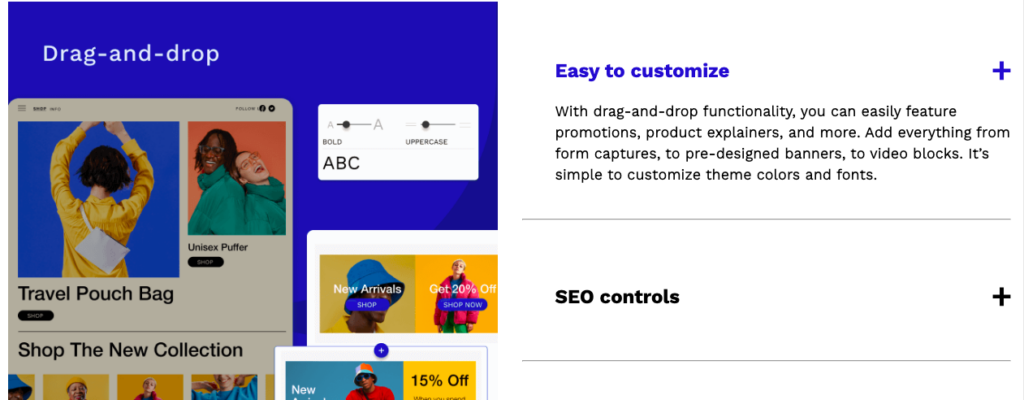
Certain advanced features such as promotional pop-ups, calendars, or booking systems are not readily available. Also, while inserting a blog is possible, it presents a challenge, suggesting a slight limitation in Web.com’s offering for content-rich sites.
For those with coding knowledge, the Advanced section opens up further customization possibilities. This area allows for the insertion of custom code, enabling a level of site personalization beyond the structured limits of the editor’s pre-made blocks and layouts.
It’s a valuable tool for users looking to implement specific features or integrate third-party services not supported natively by Web.com.
Despite these challenges, connecting your site to Google Analytics is straightforward and recommended. Analytics integration is key for tracking your website’s performance and understanding visitor behavior, insights that are critical for refining and optimizing your site over time.
In conclusion, while Web.com offers a solid foundation through its template selection and customization options, users looking for high levels of customization or specific advanced features may need to look beyond its offerings, or consider leveraging the advanced code integration capabilities for a more customized solution.
Customer Support: Getting Help When You Need It
When things don’t go as planned, having a reliable customer support team to turn to is crucial. Web.com aims to provide its users with a variety of channels to get the assistance they need, whether they’re facing technical difficulties, have questions about services, or need guidance on using the Web.com platform.

Understanding the available support options can help users quickly resolve their issues, ensuring minimal disruption to their online activities.
- Phone Support: Available 24/7, this is the backbone of Web.com’s customer service. Whether you’re up late at night or early in the morning, you can reach out to their support team for immediate help.
- Email Support: For less urgent inquiries, sending an email can be a convenient option. Web.com promises to attend to email requests with the same level of attentiveness as they do for phone calls.
- Live Chat: Ideal for real-time assistance during business hours, the live chat feature allows you to communicate directly with customer service representatives for quick solutions.
- Support Tickets: Through the Web.com platform, users can submit detailed support tickets. This option is particularly useful for complex issues that require in-depth investigation.
- Knowledge Base: For self-service support, Web.com offers an extensive library of articles covering a wide range of topics. This resource is great for users who prefer to find answers at their own pace.
Choosing the right support channel depends on the nature of your issue and your preferred method of communication. Having multiple options ensures that you can always find help when you need it, keeping your website running smoothly.
Web.com’s Customer Service: Efficient or Lacking?
Customer service quality can significantly affect your experience with a service provider. At Web.com, customer service receives mixed reviews.
While some users report positive experiences with knowledgeable and helpful staff, others suggest that the service can be hit or miss. Critical feedback often highlights prolonged wait times, inconsistent quality of support, and a focus on upselling rather than problem resolution.
Web.com for E-commerce: Features and Limitations
Web.com offers a platform that caters to the needs of online businesses with varying degrees of functionality across its plans.
From the capability to sell a wide range of products to integrating with major payment gateways like Stripe, PayPal, and Square, it provides foundational tools necessary for starting and managing an online store.
Also, the ability to create discount codes and handle an unlimited number of product variants enables businesses to cater to diverse customer needs and preferences effectively.
However, there are limitations to be mindful of. The platform restricts the number of products you can sell to 500 under specific plans, which may not suffice for expanding businesses.
Furthermore, the lack of support for digital downloads, gift cards, in-store pickups, and local deliveries may limit how you can serve your customers and expand your market reach.
The advanced e-commerce features like inventory management or abandoned cart recovery, crucial for optimizing online store operations, are also missing, or available only at premium levels.
The comparison with other website builders highlights a gap in the sophistication of features and customization options.
While Web.com offers essential e-commerce functionalities, businesses looking for a more customizable and feature-rich platform may find it lacking. This emphasizes the importance of evaluating your business needs against the features provided before settling on a platform.
How to Leverage Web.com for Your Online Store
Leveraging Web.com for your online store starts with understanding the platform’s strengths and using them to your advantage. Here are some strategies:
- Utilize the multiwarehouse functionality: If you stock products in multiple locations, Web.com’s ability to track products stored in various places helps manage your inventory efficiently.
- Explore multichannel fulfillment: For businesses subscribed to the eCommerce Premium plan, taking advantage of Amazon multichannel fulfillment and fulfillment automation capabilities can streamline the shipping and handling process, making it easier to scale operations.
- Maximize the SEO tool: Web.com comes with an integrated SEO tool that provides monthly health checks and a custom action plan for your site. Using this tool can improve your site’s visibility, draw more traffic, and potentially increase sales.
- Integration of payment gateways: Offering multiple payment options can improve customer experience. By utilizing Web.com’s support for popular payment services like Stripe, PayPal, and even cash on delivery, you can cater to a broader range of customer preferences.
- Automate inventory sync: With Web.com’s 24/7 automated inventory sync technology, you can ensure your product quantities are accurately shown across all selling platforms. This reduces the risk of overselling and keeps your customers informed about product availability.
To successfully leverage Web.com for your online store, consider constructing a personalized strategy that aligns with your business model and customer needs. Focus on utilizing the platform’s specific strengths, such as easy payment gateway integrations, inventory management in multi-warehouse settings, and robust SEO tools.
In wrapping up, it’s clear that while Web.com has its limitations, it also offers valuable features for launching and managing online stores. By strategically utilizing these features and supplementing the platform’s offerings with additional tools as needed, businesses can create a thriving online presence.

Making the Decision: Is Web.com Right for You?
Deciding on the right website builder for your business or personal project is a significant step towards establishing your online presence.
In the sea of website builders, Web.com positions itself as a straightforward solution, catering primarily to those without in-depth technical knowledge. Before diving into the commitment of choosing Web.com, it’s crucial to assess whether it aligns with your needs, budget, and long-term goals for your online project.
Consider factors such as ease of use, feature set, scalability, and cost against your specific requirements. Whether you’re developing an online store, a portfolio, or a business website, ensuring the platform meets your expectations is key. Also, consider the level of customer support and community resources available to assist you throughout your website building journey.
Web.com Compared to Competitors: A Comprehensive Analysis
When comparing Web.com to its competitors, several factors come into play. Each website builder has its unique strengths and features aimed at specific user needs.
- Price: Web.com’s plans, especially with introductory offers, present an attractive starting point for many. However, it’s important to note that these costs might rise after the initial period, and assessing the long-term budget fit is essential.
- Usability: For users with limited technical skills, Web.com offers a straightforward route to get a website up and running, courtesy of its AI-driven design process. This approach could be a significant advantage over platforms that require a steeper learning curve.
- Features: While Web.com provides an array of basic functionalities suitable for getting a simple site off the ground, platforms like Wix and Squarespace might offer a more robust feature set, including extensive customization options, advanced SEO tools, and a broader selection of templates.
- Scalability: Consider your long-term plans. If you anticipate significant growth, platforms with a comprehensive ecosystem like Shopify or an extensive set of advanced features might be better suited to your needs. Web.com, with its basic offering, might fall short for more complex e-commerce sites or those requiring high levels of customization.
In summary, Web.com could be the right choice if you’re looking for simplicity and a manageable starting point without needing extensive web design or development expertise.
However, for those looking for greater flexibility, more comprehensive e-commerce solutions, or advanced design and SEO tools, exploring alternatives such as Wix, Squarespace, or Shopify might yield a platform better matched to your requirements. Always compare the ongoing costs, not just the attractive initial pricing, and consider the potential need to migrate to a more scalable platform in the future.
Choosing the right website builder is a decision that shouldn’t be rushed. Reflect on your immediate needs and future ambitions, and select a platform that not only meets your current expectations but also has the capacity to support your growth.
Remember, transferring a website later can be a complex process, so selecting a platform that can scale with you is advisable.
Conclusion: Your Next Steps With or Without Web.com
Deciding on the right website builder for your personal or business needs can seem challenging with the myriad of options available. For small businesses aiming to establish an online presence without breaking the bank, Web.com presents itself as an option. It boasts of a simple, AI-powered site creation process and a range of tools designed to get your website up and running quickly. However, it’s crucial to weigh its offerings against your specific requirements and budget.
If the simplicity and AI integration of Web.com align with what you’re searching for, give their platform a try, especially if your focus is on getting started swiftly and without much fuss.
Their unique AI chatbot can streamline the website-building process, making it particularly appealing for those with limited web development experience. Yet, if you prioritize flexibility, a broad range of design options, and comprehensive customer support, exploring alternatives could prove beneficial.
For those prioritizing design freedom and extensive features, Wix represents a solid alternative, boasting an intuitive drag-and-drop interface and an extensive template library. HostGator, on the other hand, offers competitive pricing and flexible payment plans, ideal for users seeking an affordable yet reliable web hosting solution.
If the aim is to launch an online store, Shopify emerges as a top choice, simplifying eCommerce setup with its user-friendly platform and robust tools. Each of these alternatives caters to different aspects of web development and comes with its unique set of advantages.
In conclusion, your next steps should reflect a balance between your website needs and the offerings of a website builder. If Web.com’s features resonate with your project requirements, it might just be the starting point you need. Conversely, if your criteria extend beyond their services, considering alternatives like Wix, HostGator, or Shopify are prudent steps towards finding a platform that truly suits your ambitions.
Pros of Web.com’s customer service include:
- 24/7 phone support availability, ensuring help is always a call away.
- Diverse support channels like email, live chat, and a comprehensive knowledge base cater to different user preferences.
- Live chat and phone support cater to users looking for immediate assistance.
Cons faced by Web.com’s customer service:
- Quality of service varies greatly among support agents, affecting user satisfaction.
- Upselling sometimes overshadows the primary goal of resolving the user’s issues.
- Live chat is not available 24/7, limiting instant support options for some users.
While Web.com attempts to offer a well-rounded customer support structure, feedback suggests there is room for improvement, especially in terms of service consistency and the elimination of pushy sales tactics.
Empowering their support team to focus on providing solutions, training for better consistency among representatives, and extending live chat hours could enhance user experience significantly.
Common Questions About Web.com Answered
Can Web.com Handle High Traffic Websites?
When considering the capability of Web.com to support high-traffic websites, it is important to understand the limits of its infrastructure. During a stress test, Web.com struggled to maintain smooth operation under the load of 50 concurrent visitors, equating approximately to 50,000 monthly visits.
However, it managed to perform without issues at 20 concurrent visitors, roughly translating to 20,000 monthly visits. While this may not meet the needs of large-scale, high-traffic websites, it is adequate for many small to medium-sized sites.
Therefore, if your website does not anticipate more than 20,000 visits a month, Web.com could be a viable option. However, for those expecting traffic surges beyond this, looking into more robust hosting options would be wise.
Is Web.com’s SEO Service Worth the Investment?
Web.com offers a variety of SEO services designed for users who may not be familiar with search engine optimization. Their approach includes one-on-one discussions with a dedicated SEO expert, strategic development, link optimization, and review of the results to ensure effectiveness.
For those lacking SEO knowledge or the time to dive deep into SEO practices, investing in Web.com’s SEO services could provide significant value. The service aims to make customers’ websites easily discoverable online, potentially leading to increased traffic and engagement. However, it’s important to note that the basic DIY website builder plan comes with only rudimentary SEO tools.
Truly benefiting from Web.com’s SEO services requires upgrading to their more comprehensive marketing plans. Consequently, whether the investment is worthwhile depends on your specific needs, your existing SEO knowledge, and whether you’re prepared to pay for higher-tier plans for more extensive support.
